

 The South African
The South African
by D C Panagos and L Faber
Field-Marshal Lord Roberts, in command of the British Army, arrived in Pretoria on 5 June 1900. Six days later his march toward Komatipoort was blocked at Diamond Hill (Donkerhoek) by Gen Louis Botha, whose forces occupied a line stretching from Boekenhout in the north to Delmas in the south. Pienaarspoort, 18 km east of Pretoria, was and important position in this long defensive line. Here the NZASM railway to Lourençco Marques (Maputo) passed through a deep gorge in the Magaliesberg. The battle of Diamond Hill was fought from 11 to 12 June 1900 along the length of this line.
On his march from Bloemfontein to Pretoria, FM Roberts had been forced to leave garrisons at strategic and important stations and bridges along the railway line, in order to secure his supplies from the Cape ports. He now had to do the same during his march to Komatipoort and on 27 July 1900, two regiments, the Connaught Rangers and the Royal Fusiliers, were ordered back from Middelburg. On 29 July they took up positions at Pienaarspoort. Here they proceeded to build redoubts and sangars, the standard defensive fieldworks of the day, using local materials mainly, producing, in this case, loose fieldstone structures similar to kraals. These were in use up to January 1901, when most of these forts were replaced by the new and more effective Blockhouse Line System.
Methods
The purpose of this research project was to examine the feasibility of using a microlight aircraft to locate and photograph from the air the fieldworks at Pienaarspoort. On early maps S.A.E.C. 1:50000 - 1930, S.A.E.C. 1:50000 - 1941, and S.A.E.C. 1:50000 - 1951, only one fort is shown on the hill south of the railway line. On the Trigonometrical Survey map 1969/1970 1:50 000, two forts are shown at this position. This microlight survey has revealed the remains of 11 forts on the northern hill and 10 on the southern hill.
Aerial surveys have been used to locate archaeological sites since the 1920s. In Syria and Mesopotamia early pioneers of the technique were Pere A Poideband and Sir Aurel Steyn. In South Africa some notable surveys were carried out by Mason, Seddon and Maggs.
However, the cost of using a normal aircraft with specialized cameras is beyond the resources of the average part-time researcher. In the case of the microlight aircraft flying expenses were R30 per hour. The camera used was a Pentax 50 mm F/1.7 M E Super operated by the observer. 100 ASA colour slide film was chosen in the hope that projected photographs would reveal more detail. That hope was not always realized, and in fact this introduced the problem of having to convert from colour slides to colour prints, the latter being necessary for the ground survey. In future we will use a colour print film and will choose faster film, in the region of 400 ASA, to eliminate streaking due to aircraft movement and vibration. The aperture was set at 5.6 and seemed to be adequate in the morning light. The observer was also responsible for pinpointing locations on the map strapped to the thigh. No specialized equipment was required.
A high degree of responsibility rests on the pilot who in this case was Mr Les Faber, a commercial pilot with extensive experience on microlight aircraft. Much of the flying was done at low altitudes where the pilot had to be very aware of the effects of air currents in hilly areas. The pilot's advice as to whether flight conditions were suitable or not was always accepted without question. It should therefore be understood that flying conditions can and did affect the progress of the work and this should be taken into account when planning any similar survey.
All flights were made early in the morning in order to take advantage of (a) still air conditions when the risk of air current turbulence is least, and (b) when the slanting sun's rays cast deep shadows on the ground. These shadows enhance vertical features for visual location as well as for photography.
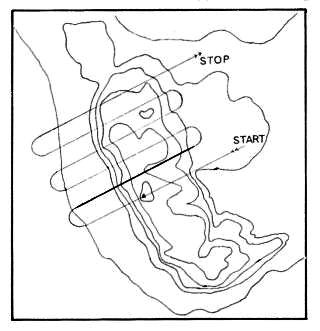
Fig.1. Flight path of search pattern
Having ascertained that military structures were present at Pienaarspoort, and armed with the necessary aerial plots and photographs, we started with ground surveys for each flight record. This entailed locating the various structures on the ground by using the aerial plot, confirming each structure using the aerial photo, measuring their plan forms and remaining walls, recording surface finds in the adjacent areas, and taking photographs to record the present day appearance of the structures.
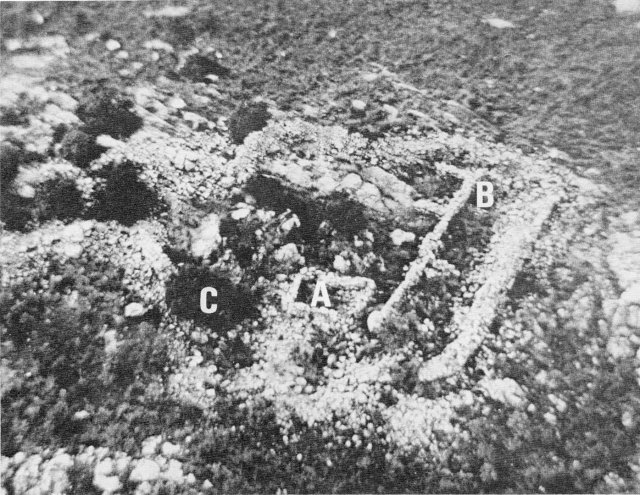
Elaborate redoubt with a shed foundation A,
a sick bay (?),B, and the possible later
addition of a Rice pattern block house
at C. These are shown in Fig. 2
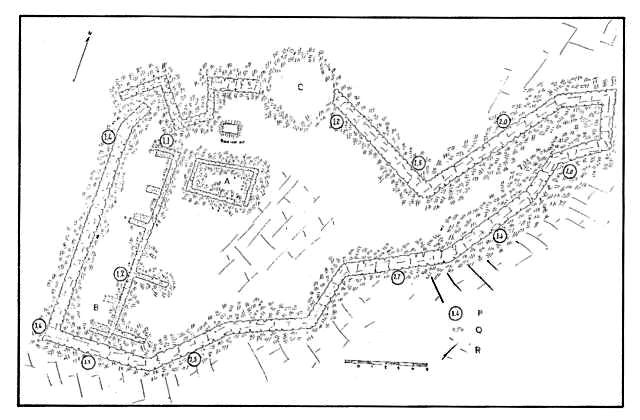
Fig. 2. Redoubt sketch plan. The finds at this site
were corrugated iron strips, barbed wire, ration tins,
a .303-in Mk II C cartridge (unfired) and a
domed brass tunic button.
Symbols: P = wall heights, Q = collapsed rubble,
R = rock outcrop
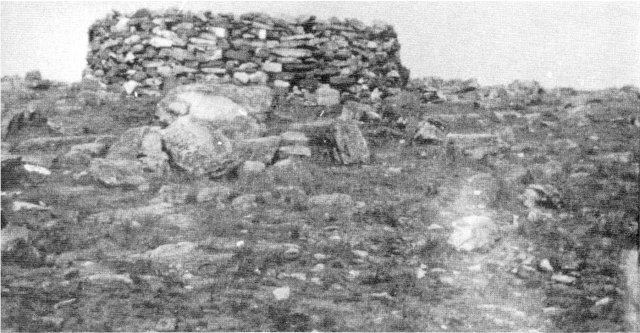
Circular loopholed sangar on South Hill
(Jourdains Album 1900)
Considering that only one or two days a month were available for the recording work, there is no doubt that the area could not have been surveyed as quickly or as thoroughly on foot. It should be noted that the top of the Magaliesberg Range is a plateau with longitudinal ridges, and therefore it is very easy for a small party to pass by a structure without noticing its presence. With the possession of an aerial plot this problem was eliminated. In addition to this, the certain knowledge that the forts were present, as a result of the aerial survey, made the laborious climbs up the mountain worthwhile.
One of the strongest motives for carrying out this survey was the fact that these forts, built as recently as the Anglo-Boer War, are today being mistaken for other structures of different origins and ages. One misconception is that the remains of a corrugated iron blockhouse with the corrugated iron shield removed, was a gun position. Similar ruins have been described as herders' hut circles. It is common to find a redoubt being regarded as simply another kraal. The aerial survey therefore led to the completion of a comprehensive picture showing that the forts and ancillary structures were an integrated military defensive position.
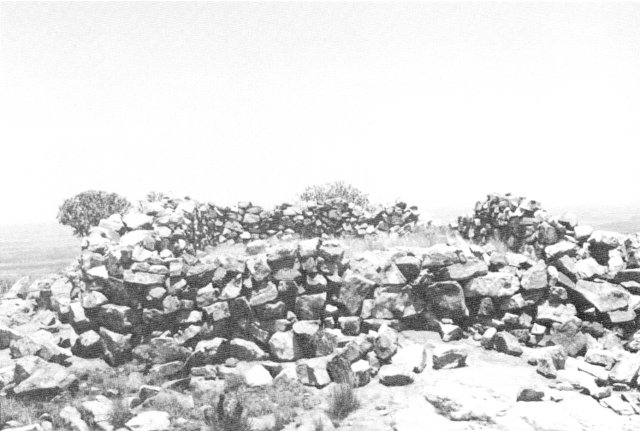
Remains of Circular Sangar on South Hill 1986
This project was made possible with funding from the Human Sciences Research Council. Without the co-operation of the National Army Museum in London the survey of the forts would not have been so interesting and would have lacked the confirmation that they were built by the Connaughts and Fusiliers, in mid 1900. I would also like to thank members of the South African Archaeological Society who visited the area with me, ignoring blistering temperatures. I am most grateful to Mr Patrick Moore of the Transvaal Provincial Administration Museum Service who has read and corrected the interim report, as well as this article. A very special word of thanks to Miss Theresa Clutty of the Transvaal Museum, for her typing and help with the ground survey, and of course to Mr Les Faber, whose impressive flying provided the essential structure upon which the project depended.
References
1. E H Bethell. The Blockhouse System in the South African War.
London, 1904). (Professional Papers of the Royal Engineers).
2. J P C Laband & P S Thompson. Field Guide to the War in Zululand
and the Defence of Natal. 1879. (Pietermaritzburg 1983).
3. H F N Jourdain & F Fraser. The Connaught Rangers. (London. 1924).
4. H F N Jourdain. The Connaught Rangers. Regimental Records, 1899-1902. Not in print.
5. Capt (Lt Col) Jourdain. Note Books. Not in print.
6. C F Romer & A F Mainwaring. The Second Battalion Royal Dublin
Fusiliers in the S.A. War. (London, 1908).
7. R J Mason. 'Transvaal and Natal Iron Age Settlement revealed hy
Aerial photography and excavation'. African Studies, Vol. 27, No.4, 1968.
8. J D Seddon. An Aerial Survey of Settlement and Living Patterns in the
Transvaal Iron Age: Preliminary Report. African Studies, Vol. 27, No.4, 1968.
9. T M O'C Maggs. 'Iron Age Communities of the Southern Highveld' (Pietermaritzburg, 1976).
Return to Journal Index OR Society's Home page
South African Military History Society / scribe@samilitaryhistory.org